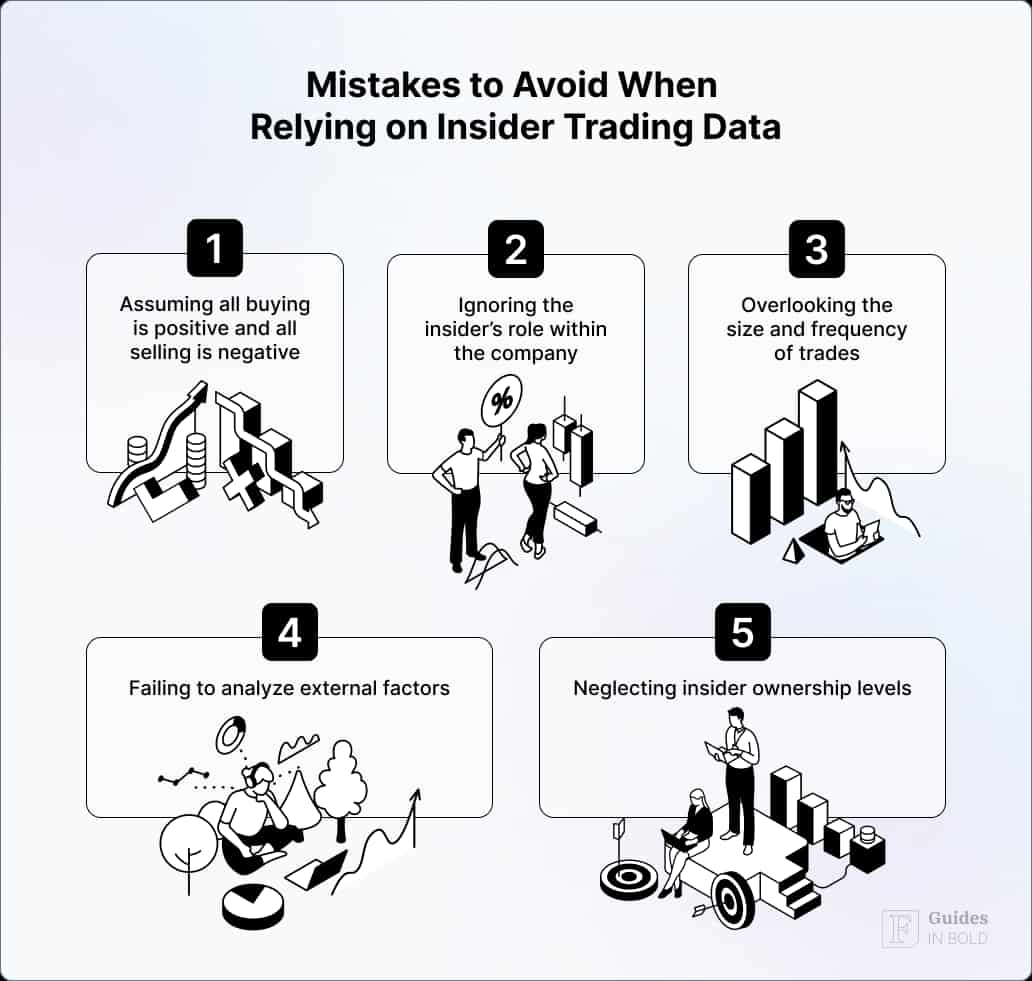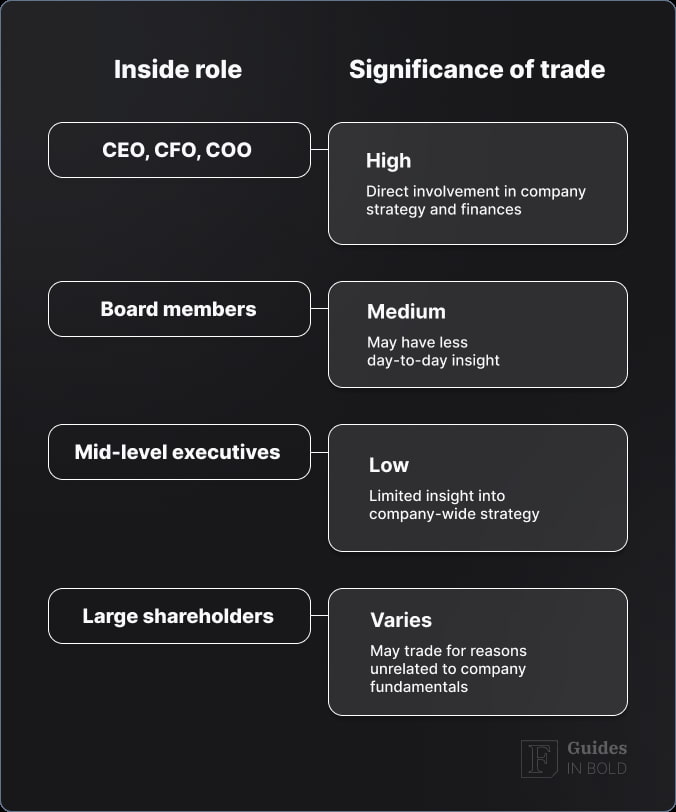Insider trading data can offer a glimpse into the decisions and confidence levels of company executives, directors, and large shareholders. However, some misunderstand or misuse this information, leading to poor investment decisions. In this guide, we’ll look at common mistakes investors make when relying on insider trading data and offer tips to avoid them.
Receive Signals on SEC-verified Insider Stock Trades
This signal is triggered upon the reporting of the trade to the Securities and Exchange Commission (SEC).
What is insider trading data?
However, not all insider trading is illegal. Executives and board members can legally buy and sell shares of their companies, but they must disclose these transactions to the Securities and Exchange Commission (SEC). Investors often use this data to try to predict the confidence insiders have in the future of the company.
Recommended video: Insider Trading Explained in 2 Minutes
That said, while insider trading can offer insights, there are a few mistakes to watch out for. So, let’s check these out, shall we?

How to track insider trades?
Receive Signals on SEC-verified Insider Stock Trades
This signal is triggered upon the reporting of the trade to the Securities and Exchange Commission (SEC).
#1: Misinterpreting the purpose of insider transactions
The first common mistake is assuming that all insider buying is a sign of future stock appreciation and that all insider selling indicates trouble ahead.
Insiders buy and sell shares for a variety of reasons, not all of which are related to the company’s future prospects. For instance, an executive might sell stock to diversify their portfolio, fund a personal expense, or comply with a pre-arranged trading 10b5-1 plan.
On the flip side, buying might not always mean they have insider knowledge of future growth. Insiders could merely believe the stock is undervalued but still be wrong about the company’s future performance.
In fact, research supports the idea that insider buying isn’t always a surefire predictor of stock performance. A 1986 study by Seyhun analyzed insider trading patterns and found that while insider buying can sometimes signal future growth, it isn’t always reliable. Insiders may buy because they believe the stock is undervalued, but even they can misjudge the company’s future performance.
Key takeaway
#2: Ignoring the insider’s role in the company
Next up, we must say that not all insiders are equal. For instance, a CFO’s stock sale may carry more weight than a mid-level executive’s, given that the CFO has a closer understanding of the company’s financial health. Unfortunately, investors often fail to consider the insider’s role in the company when analyzing trading data.
An insider close to daily operations or the company’s finances might provide more reliable indicators of a company’s future than someone in a less critical role, like a board member who only attends quarterly meetings.

Key takeaway
#3: Overlooking the size and frequency of trades
The third common mistake is focusing on a single trade without considering its size or frequency.
Namely, a $10,000 buy from a CEO might not be as significant as a $500,000 purchase from the same individual. Likewise, multiple small trades over time may indicate more confidence than a single large transaction. The more significant the insider’s stake in the company, the more confidence the trade will show.
“Insiders might sell their shares for any number of reasons, but they buy them for only one: they think the price will rise.” — Peter Lynch, famous investor
Investors should also be aware of patterns of trading over time. Consistent buying over several months may indicate growing confidence, while sporadic buying and selling could suggest other factors at play.
Key takeaway
#4: Failing to analyze external factors
Sometimes, insider trades are motivated by external factors unrelated to the company’s future performance. Investors often overlook these external influences, which can lead to faulty conclusions. For example:
- Market conditions: Broad market declines or rallies can drive insiders to buy or sell stocks;
- Tax planning: Insiders may sell shares to cover tax liabilities;
- Pre-arranged trading plans (10b5-1 plans): These plans allow insiders to set up automated sales ahead of time, meaning the timing of the sale may not be influenced by recent company news;
Key takeaway
#5: Neglecting insider ownership levels
Finally, one of the biggest mistakes investors make is not considering the insider’s total ownership in the company.
A CEO who owns 5% of the company and sells 1% of their shares might not indicate a lack of confidence, but rather rebalancing their portfolio. On the other hand, if a high-level executive who owns a small percentage of the company suddenly sells half of their shares, it could be a red flag.
| Ownership level | Significance of insider trades |
| High ownership levels | Insider trades are more significant when insiders have large stakes in the company. |
| Low ownership levels | Selling a small stake may not carry much weight. |
Key takeaway
A quick recap of the common mistakes to avoid
- Assuming all buying is positive and all selling is negative;
- Ignoring the insider’s role within the company;
- Overlooking the size and frequency of trades;
- Failing to consider external factors;
- Neglecting the insider’s overall ownership levels.
The bottom line
In summary, insider trading data can be a useful tool in making investment decisions, but it must be analyzed carefully and within context.
You should, therefore, avoid the mentioned mistakes by understanding why insiders might trade, who they are, and the broader circumstances affecting their actions. Such a careful analysis can help you use insider trading data more effectively and avoid costly errors in your investment strategy.
Furthermore, to make better use of insider trading data, consider subscribing to Finbold Signals, which delivers real-time updates on insider transactions, helping you track patterns and make more informed decisions.
Receive Signals on SEC-verified Insider Stock Trades
This signal is triggered upon the reporting of the trade to the Securities and Exchange Commission (SEC).
Disclaimer: The content on this site should not be considered investment advice. Investing is speculative. When investing, your capital is at risk.
FAQs about common insider trading mistakes
What is insider trading data?
Insider trading data shows stock transactions made by company insiders, such as executives and directors. These trades are reported publicly.
Is insider trading always illegal?
No. Legal insider trading is when insiders report their trades publicly. It becomes illegal if they use non-public information for personal gain.
How can insider trading data help with investing?
It can signal insider confidence in the company’s future. However, it’s important to analyze trades in context to avoid misinterpretation.
Is insider buying always a good sign?
Not always. Insiders might believe the stock is undervalued, but that doesn’t guarantee future growth.
What makes an insider trade significant?
Look at the insider’s role, the size and frequency of trades, and their overall ownership in the company.
What are 10b5-1 trading plans?
These pre-arranged plans allow insiders to sell shares on a schedule, meaning trades may not reflect their current views on the company.




